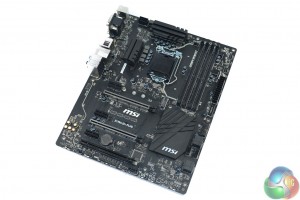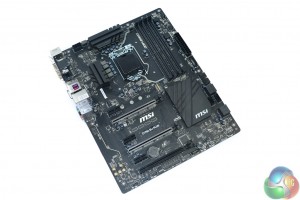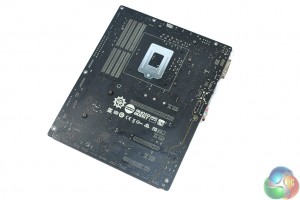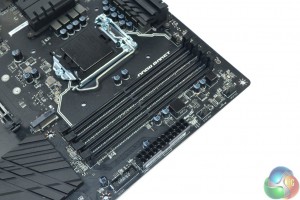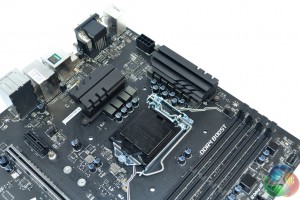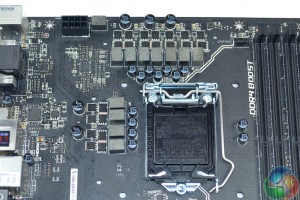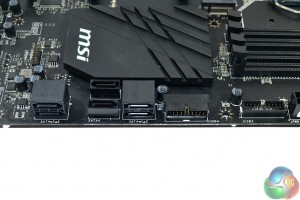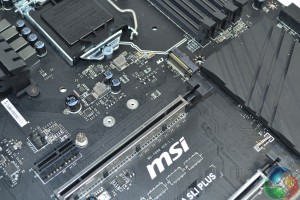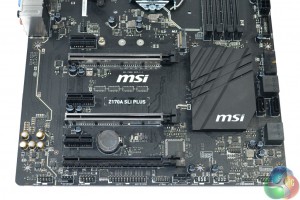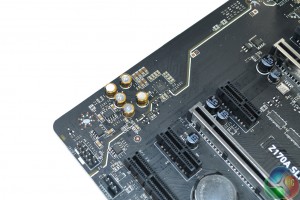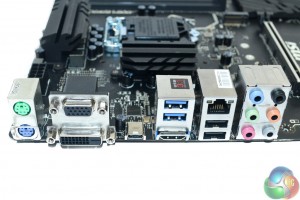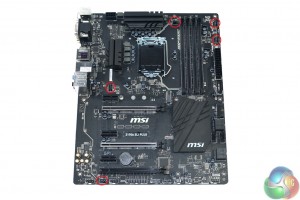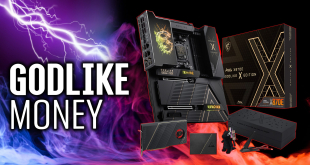The MSI Z170A SLI Plus uses a largely black colour scheme with hints of silver and white being found in certain areas of the board. I like the styling of the board as the matte black finish of the PCB matches that of the heatsinks very well.
Some users who are heavily influenced by appearance may be disappointed by the silver IO ports visible due to a lack of cover. This compromise is, however, understandable as MSI has to meet a strict budget and a rear IO cover can be deemed unnecessary expenditure.
A look at the rear PCB indicates lane allocations for the board's PCIe slots.
Up to 64GB of DDR4 memory can be installed in the four DIMM slots. Dual-channel operation is supported with MSI quoting capability with speeds as high as 3600MHz (via overclocking).
The slots are of the dual-latch variety which is fine in this scenario as interference with a graphics card will not be an issue. Debug LEDs located near to the memory slots help to indicate system issues.
Spacing around the CPU socket, in addition to relatively small VRM heatsinks, should help to mitigate CPU cooler interference concerns.
A total of eleven power delivery phases are used to feed the CPU and accompanying energy-drawing pieces of the system (namely the iGPU). MSI calls upon Intersil's 4+3 phase ISL95856 hybrid digital controller to manage the overall power delivery system.
Four of Intersil's ISL6625 dual MOSFET drivers (marked 5AZ XLP) aid the 4+3 phase PWM controller. The high- and low-side MOSFETs are Nikos PK616BA and PK632BA units.
All six of the SATA 6Gbps ports are fed by the Z170 chipset. MSI orientates four ports on their sides to assist with cable management, while a single pair faces upwards to aid compatibility with narrower cases. MSI smartly chooses the upwards-facing pair as to avoid interference with a long, dual-slot graphics card.
Two 5Gbps USB 3.0 (USB 3.1 Gen 1) headers fed by the Z170 chipset provide capacity for up to four ports. MSI again plays the compatibility game by orientating one header facing upwards and the other at a right angle.
Positioning of the 32Gbps PCIe 3.0 x4, NVMe-capable M.2 connector is wise. The slot's residence above a graphics card helps to minimise overheating concerns for an installed M.2 SSD. It also means that an M.2-to-U.2 adapter can be used without interference.
Conversely, the location also means that an M.2 SSD with an ugly green PCB will be perfectly visible and could destroy the appearance of a sleek build. Despite M.2 SATA SSDs being supported, according to MSI's QVL, I could not get a Kingston M.2 SATA SSD (which wasn't listed as compatible) to work.
There's no SATA-Express connector on offer here. And while that wouldn't usually be highlighted as negative, the uptake of SATA-Express is currently being driven forward by the connector's usefulness for providing front panel USB 3.1 connectivity via external bays. ASRock, for example, sells motherboards which come bundled with a front bay that offers two 10Gbps USB 3.1 connectors and is fed via SATA-Express.
A total of three full-length PCIe 3.0 x16 slots are found on the MSI Z170A SLI Plus motherboard. The two silver Steel Armor slots receive their PCIe 3.0 lanes from the LGA 1151 CPU and can be used as x16/x0 or x8/x8 for two-card SLI and CrossFire.
That third full-length PCIe 3.0 slot is fed by four lanes from the Z170 chipset. As such, it pays a latency penalty for graphics applications and is therefore not recommended for adding a third AMD card for 3-way CrossFire (SLI dictates a minimum x8 link speed). It is, however, ideal for the likes of a PCIe 3.0 SSD, such as Intel's SSD 750, or a different high-bandwidth add-in card.
Three open-ended PCIe 3.0 x1 connectors complete the expansion slot configuration. Slot spacing is superb for a motherboard of this calibre; two dual-slot graphics cards can be used, with a cooling gap between them, in addition to a PCIe x1 sound card and PCIe x4 SSD. There's also capacity for adding another PCIe x1 device into that mix thanks to the smart slot arrangement.
MSI deserves credit for efficient use of the Z170 chipset's 26 flexible IO lanes. The board-wide six USB 3.0 ports, six SATA 6Gbps connectors, PCIe 3.0 x4 (x16-length) slot, PCIe 3.0 x4 M.2 connector, trio of PCIe 3.0 x1 slots, and 10Gbps USB 3.1 Type-C port can all be used simultaneously. Add the Intel I219-V Gigabit NIC into the equation and that's all 26 of the chipset's flexible lanes efficiently allocated.
The Audio Boost system MSI deploys on the Z170A SLI Plus is centred on Realtek's popular ALC1150 codec. Alongside the 115dB SNR codec is a pair of Texas Instruments OP1652 operational amplifiers and Nichicon Chemi-Con audio capacitors.
Segregated audio tracks and an isolated PCB are used to minimise signal interference. However, there is no shielding on the audio codec or rear 3.5mm jacks. The lack of an optical SPDIF output is also a disappointment for users who may connect their computer to a large screen TV and surround sound speakers.
Basic is a fair descriptor for the selection of ports found on the Z170A SLI Plus' rear IO. Legacy compatibility is offered via PS/2 keyboard and mouse ports in addition to a pair of USB 2.0 connectors (which I love to see for keyboard and mouse duties). An additional pair of USB ports, this time of the 5Gbps 3.0 variety, is fed by the Z170 chipset.
A total of four USB Type-A ports on the rear IO is not enough for a Z170 motherboard. Connect up your keyboard, mouse, USB headset, and printer and you've used all of the rear panel Type-A ports available before even thinking about WiFi adapters and other devices. The configuration should have been redesigned to allow an additional pair of USB 2.0 ports to take over one of the PS/2 locations, with the remaining offering serving as a PS/2 keyboard/mouse combo option.
A 10Gbps USB 3.1 Type-C connector, fed by ASMedia's two-lane ASM1142 chipset, is undoubtedly the star of the rear IO show. It is good to see that MSI has maintained compatibility with future high-speed devices even given the board's aggressive pricing. I do not see the lack of 10Gbps USB 3.1 Type-A port, alongside the Type-C connector, as a noteworthy issue; the Type-C variant looks to be a more popular solution with external drive manufacturers.
Networking is handled by Intel's well-respected I219-V Gigabit NIC. This will please many users who do not like being forced to use a Killer-based alternative (and the accompanying software package) as is the case for many Gaming marketed motherboards.
DVI-D and VGA connectors provide compatibility with older monitors when using the integrated GPU. HDMI is also usable, but it is of the v1.4 variety and is therefore unable to run a 4K resolution at 60Hz. I would have liked to see a DisplayPort 1.2 connection provided to allow for 4K60 support, especially when DVI and HDMI are so easily interchangeable.
A total of five fan headers are scattered about the board, all of which are 4-pin and are controllable via the UEFI. Distribution of the fan headers is good – four are within easy reach of the CPU socket, the necessary rear chassis fan spot is filled, and most are close enough to the board's edge to ease cable management duties.
Management of the fan headers, in addition to system-wide monitoring, is the responsibility of Nuvoton's NCT6793D-M chipset.
 KitGuru KitGuru.net – Tech News | Hardware News | Hardware Reviews | IOS | Mobile | Gaming | Graphics Cards
KitGuru KitGuru.net – Tech News | Hardware News | Hardware Reviews | IOS | Mobile | Gaming | Graphics Cards


